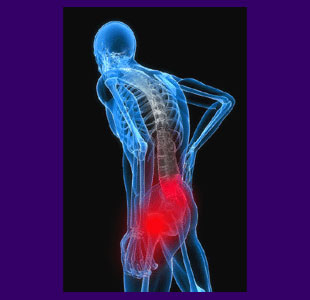
A painful sciatic nerve is one of the most common of all patient complaints and usually results in discomfort and neurological symptoms in the buttocks, legs and/or feet. Some patients have symptomatic expressions in just certain areas of the lower body, while others endure a radiating, burning line of pain from the back to the foot and everywhere in-between. The sciatic nerve is a bilateral neurological structure with left and right branches connecting the spinal nerve roots of the lower lumbar and upper sacral regions to the network of local tissues that innervate the buttocks, legs and feet.
Sciatica is a symptom of some underlying causative condition, but should never be the basis of a diagnosis unto itself. If your doctor pronounces, “You have sciatica”, your reply should be “No kidding, genius. What is causing it?”
This article provides an overview of pain that exists in the sciatic nerve and profiles the clinical patterns of sciatic nerve symptoms.
What Causes a Painful Sciatic Nerve?
True sciatica denotes a spinal source, most commonly a herniated disc at L4/L5 or L5/S1. Other times the condition is blamed on spinal arthritis, often detailed as bone spurs or an osteophyte complex on an MRI report. Less frequently, sciatica is traced back or some other structural issue in the lumbosacral spine, such as scoliosis, lordosis or spondylolisthesis.
In some instances, sciatic nerve symptoms might result from central spinal canal narrowing in the neck. While not fitting the traditional definition of sciatica, cervical spinal stenosis can still enact a condition that mirrors it in every way imaginable, often with the addition of problems standing and walking, for severe canal impingement scenarios.
Pseudosciatica describes pain, and related nerve symptoms in the sciatic structure that are not caused by a spinal source. The sciatic nerve can be affected by structural compression from muscular tissues, such as in the case of piriformis syndrome. The sciatic nerve can also be damaged or affected by trauma, tumors or a variety of disease processes.
The last major causation of sciatic nerve discomfort is oxygen deprivation. This agonizing process can be enacted by circulatory concerns in some rare circumstances, but is usually part of a larger mindbody syndrome, in which the ischemia is purposefully created by the patient’s subconscious mind.
Ischemia can not only strike the sciatic nerve itself, but also the surrounding muscles and other soft tissues, enacting the usual complaint of simultaneous lower back pain and associated leg and foot symptoms. Many instances in which a herniated disc is blamed for causing pain are mistakenly identified, when ischemia is the actual culprit. This is usually discovered when the symptoms experienced are far too wide-ranging to be explained from a single herniation and the result of testing shows multiple nerve roots implicated, even though there is only one bulging disc. In these very common cases, oxygen deprivation might be the real source of pain and the herniated disc is purely coincidental to any symptoms expressed.
Oxygen deprivation is the least often diagnosed reason for a painful sciatic nerve to occur, which is strange, since it is an incredibly common causation. Unfortunately, mindbody symptoms fall outside of a medical providers typical training and are therefore rarely considered, even when their true origin seems virtually undeniable.
Painful Sciatica Patterns
Regardless of the cause of pain, there are many symptomatic patterns that might be present in a sciatica syndrome. The following section details many of the most often cited neurological pain expressions:
Symptoms might include pain, paresthesia, burning, numbness and weakness. Some symptoms, such as numbness or weakness, might be subjective or objective, meaning a perceived feeling versus an actual and verifiable presentation.
Symptoms might be truly consistent, consistent for a time, random and often changing, or cyclical in definite or random patterns.
Symptoms might be present all the time or only sometimes. For occasional symptoms, position or activity might play a role in escalation or relief.
Symptoms might be of consistent degree or might be worse sometimes and less severe other times.
Symptoms might be unilateral or bilateral. Over 80% of patients cite unilateral pain as the most common variety they experience.
Painful Sciatic Nerve Evaluation
Since there are so many possible instigators of sciatic nerve symptoms, and so many different possible expressions, finding the true origin can be a convoluted process. It should be of no surprise that sciatica is one of the least often cured of any lower back pain condition.
The crucial thing to always keep mind is that it may take much time and a considerable investment of personal effort into achieving a correct diagnosis. You must not give up or accept an unproven or incorrect theory, just because it is convenient.
Most patients who have endured years of unsuccessful treatment, like to place blame. They blame their doctors, their treatments and their insurance carriers. However, when we review their individual circumstances, much of the blame for their failed treatment falls squarely on them. We hate to say it, but it is true.
Most patients simply do not bother to take the time to learn anything about why their pain exists. They simply go with the flow and allow doctor after doctor to take advantage of their ignorance, while these caregivers get filthy rich. Sadly, many patients end up permanently damaged by unneeded surgical interventions that are used to treat incorrect sciatica diagnoses. The sciatica treatment sector is a real minefield for patients. One wrong move and you can find yourself in a far worse place in life than you ever imagined. Do not allow this fate to befall you. Learn. Question. Grow. It is your life. It is your health. Take it back with knowledge.





